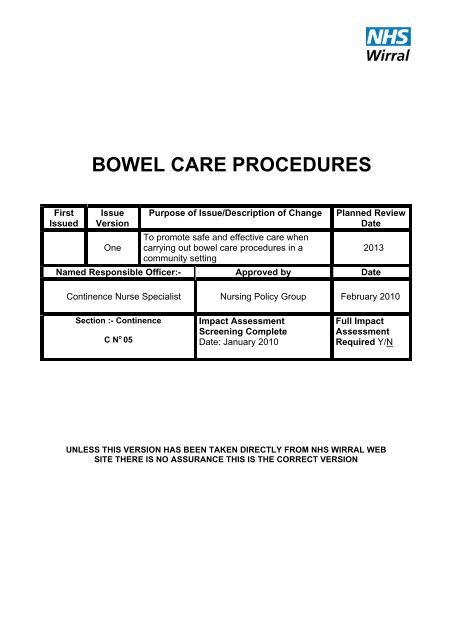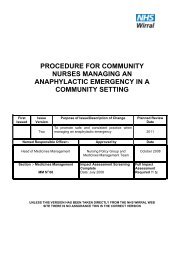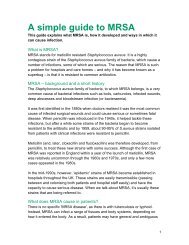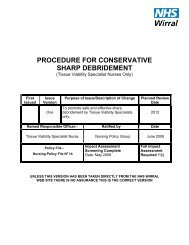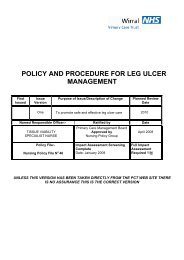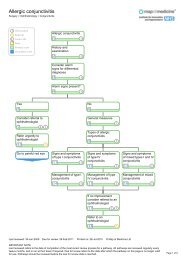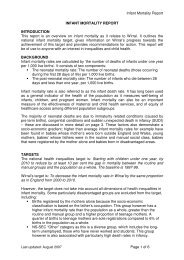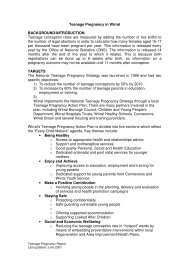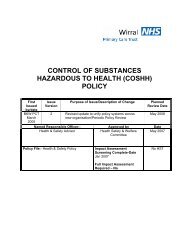bowel care procedures
bowel care procedures
bowel care procedures
You also want an ePaper? Increase the reach of your titles
YUMPU automatically turns print PDFs into web optimized ePapers that Google loves.
BOWEL CARE PROCEDURESFirstIssuedIssueVersionPurpose of Issue/Description of ChangePlanned ReviewDateOneTo promote safe and effective <strong>care</strong> whencarrying out <strong>bowel</strong> <strong>care</strong> <strong>procedures</strong> in a2013community settingNamed Responsible Officer:- Approved by DateContinence Nurse Specialist Nursing Policy Group February 2010Section :- ContinenceC N o 05Impact AssessmentScreening CompleteDate: January 2010Full ImpactAssessmentRequired Y/NUNLESS THIS VERSION HAS BEEN TAKEN DIRECTLY FROM NHS WIRRAL WEBSITE THERE IS NO ASSURANCE THIS IS THE CORRECT VERSION
BOWEL CARE PROCEDURESINDEXContentsPage NumberIntroduction 3Procedure aim 3Procedure outcomes 3Target group 4Training 4Related policies 4Risk Assessment 4Medication Review 5Circumstances where extra <strong>care</strong> is required 5Exclusions and contra-indications 5Patients who lack capacity 6Sensitivities 6Observation of the perianal and perineal area 6PROCEDURESDigital Rectal Examination 7-8Insertion of Suppositories and Enemas 9-11Digital Removal of Faeces 12-15Digital Rectal Stimulation 16-19Care & Management of Autonomic Dysreflexia 19-20Further Reading 20References 21Appendix 22BOWEL CARE PROCEDURES2/22
INTRODUCTIONBOWEL CARE PROCEDURESThis procedure will outline the professional and legal aspects of Digital RectalExamination, Insertion of Suppositories and Enemas, Digital Removal of Faeces, andDigital Rectal Stimulation. The procedure is based upon standards from the Royal Collegeof Nursing (2006 & 2008).With advances in oral, rectal and surgical treatments, the need for these <strong>procedures</strong> havebeen reduced (Kyle et al 2005). However, they may still be required as an acuteintervention or as part of a regular <strong>bowel</strong> management programme for patients withneurological conditions or Spinal cord Injury (Powell & Rigby 2000).Nurses commonly encounter patients on their caseload with acute <strong>bowel</strong> dysfunctionincluding constipation and faecal incontinence and it is not uncommon for the nurse to bethe key person who will assess, treat and manage these conditions. If patients withconstipation or faecal impaction are referred by a General practitioner but are not currentlyon the District Nurses caseload or present with severe pain, nausea, vomiting or fever,they should be seen by their General Practitioner to exclude other conditions such as<strong>bowel</strong> obstruction.A Bowel Management Programme may incorporate a combination of the above<strong>procedures</strong>, which are performed in a particular order to achieve a predictable evacuationof the <strong>bowel</strong>. Its aims are to avoid constipation or faecal incontinence and reduce the riskof long term complications (Coggrave 2008). Loss of <strong>bowel</strong> function can have a significanteffect on quality of life, with implications for independence, and long term health (Coggraveet al 2009). For the Spinal Cord injured patient, developing such a programme is aspecialist field and results in a highly individualised <strong>bowel</strong> management programme(Coggrave et al 2009) – alterations to management should only be undertaken followingdiscussion with the patient’s Spinal Injury Unit (RCN 2008). Failure to support patients intheir <strong>bowel</strong> management programme can place them at risk of autonomic Dysreflexia(National Patient Safety Agency 2004).PROCEDURE AIMThis procedure aims to ensure that patients in the community setting who require any ofthe above <strong>bowel</strong> interventions have the procedure carried out in a safe and timely manner.PROCEDURE OUTCOMESThis will enable nurses to:-• Comply with evidence based NHS Wirral Procedures for Bowel Care• Recognise the signs, symptoms and management of Autonomic Dysreflexia• Be aware of the varying issues of consent for performing this procedure• Consider the cultural and religious beliefs prior to performing this procedure.• Assess which group of patients are suitable for this type of interventionTARGET GROUPBOWEL CARE PROCEDURES3/22
This procedure applies to all clinical staff directly employed by NHS Wirral, who arerequired to carry out this role and have attended the in-house Continence Care Course.TRAININGAll registered nurses will attend the in house Continence Care Course within six months ofjoining organisation and thereafter every three years. This is a two day in house courseprovided by the Continence Service.RELATED POLICIES• NHS Wirral Record Keeping Procedure for Community Nursing• NHS Wirral Health Records Policy• Nursing and Midwifery Council (NMC 2008) The Code: Standards of Conduct,Performance and Ethics for Nurses and Midwives• NHS Wirral Consent Policy• Chaperone and Intimate Care Policy• Health and Safety Policies• Infection Control Policies• Disposal of clinical waste policy• Incident Reporting policy• Essence of Care – Privacy and Dignity (2003)NB Always use most current versions of NHS Wirral and NMC policies as may besuperseded at any timeBOWEL ASSESSMENTNurses need to complete a <strong>bowel</strong> assessment by completing a Wirral IntegratedContinence Service Bowel Pathway Documentation, forms available from the ContinenceService.RISK ASSESSMENTIn some circumstances, differences of opinions occur between the patient, <strong>care</strong>r and nurseover the need for these interventions. Full consultation between the patient, the <strong>care</strong>r willhelp clarify why the procedure is required (RCN 2008). Wider consultation with theGeneral Practitioner, the injured patient and their spinal injury unit, may be required in thepatient’s best interests.Potential Risks Include:• Damage to the anal and rectal mucosa• Stretching of the anal sphincter, potentially resulting in faecal incontinence• Allergies – including latex, soap (Lanolin), phosphate and peanuts (present inarachis oil enemas).• Autonomic Dysreflexia (see page 20)• Complete a separate risk assessment prior to carrying out <strong>bowel</strong> <strong>procedures</strong> forthese patients.BOWEL CARE PROCEDURES4/22
MEDICATION REVIEWFollowing an episode of constipation, faecal impaction or faecal incontinence the patient’smedications should be reviewed as many drugs may have possible side effects on gutmotility and stool consistency.The main groups are:• Broad spectrum antibiotics • Opiods• Laxatives • Anti Diarrhoeals• Obesity Medication • Anti Depressants• Antimuscarinics • Anti Histamines• Iron Preparations • AntacidsConsider requesting a medication review if the patient is taking four or more medications,which may be contributing to <strong>bowel</strong> dysfunction, by referring to the MedicinesManagement Team, using the referral form available on the NHS Wirral Intranet site underMedicines Management/documents.Check patients understand potential side effects of their medications and how to managesymptoms. Refer to General Practitioner if required.CIRCUMSTANCES WHERE EXTRA CARE IS REQUIREDIn the following circumstances, nurses should fully document the clinical rationale forperforming the <strong>procedures</strong> including any advice or recommendations from the GeneralPractitioner or Continence Service.• Active inflammation of the <strong>bowel</strong> e.g. Crohn’s Disease, Ulcerative Colitis,Diverticulitis etc.• Recent radiotherapy to the pelvic area• Rectal/anal pain• Obvious Rectal Bleeding• Tissue fragility due to age/radiation, loss of muscle tone in neurological diseasesor malnourishment• If the patient has a known history of abuse• If the patient has a history of allergies i.e. Latex, Lanolin, Peanuts, Phosphate• The patient gains sexual satisfaction from the procedure – in these circumstancesconsultation with other members of the team, including the team leader is advised,involving the patient in that consultation. Fully document outcome in patient’s healthrecordsEXCLUSIONS AND CONTRA-INDICATIONS• Where there is a lack of valid consent from a patient with capacity• The patient’s doctor has given specific instructions that these <strong>procedures</strong> are not totake place• The patient has recently undergone rectal/anal surgery or trauma• Rectal bleeding of unknown cause• Malignancy of the perianal areaBOWEL CARE PROCEDURES5/22
PATIENTS WHO LACK CAPACITYSituations may arise where the need for these <strong>procedures</strong> has been deemed in thepatients best interests. This would need full consultation with <strong>care</strong>rs/family close to thepatient including the General Practitioner and the Specialist Continence Nurse if required,with the outcome fully documented in the patient’s health records. Complete ConsentForm Four.If the patient has a Lasting Power of Attorney for Personal Welfare, they should beinvolved in the discussion to determine the patients best interests.SENSITIVITIES• Patients should be informed that they have the right to request a chaperone whenundergoing this procedure. If a chaperone cannot be provided, the patient must beinformed and asked if they wish to continue with the procedure. Their decisionshould be recorded in the patient’s records.• Where intimate <strong>procedures</strong> or examinations are required, be aware of any culturaland religious beliefs or restrictions the patient may have which prohibit thisprocedure being done by a member of the opposite sex.• Comply with NHS Wirral Consent Policy if translators are required, use only NHSWirral recommended translators.OBSERVATION OF THE PERIANAL AND PERINEAL AREABefore performing these <strong>procedures</strong>, check for abnormalities, document and report ifrequired:• Rectal prolapse• Haemorrhoids• Anal skin tags• Infestation• Bleeding and the colour of the blood• Pressure ulcers of all grades(complete incident form if level 2 orabove)• Wounds, dressings, discharge• Anal lesions (malignancy)• Gaping anus• Foreign bodies• Skin conditions, broken areas• Faecal matter/ stool consistency(refer to Bristol Stool ChartAppendix 1)BOWEL CARE PROCEDURES6/22
PROCEDURE FOR DIGITAL RECTAL EXAMINATION IN ADULTSINDICATIONS FOR DIGITAL RECTAL EXAMINATION (DRE):• To assess presence of stool in the rectum, amount and consistency• To assess the need for rectal medication• To evaluate the efficacy of interventions/medication• To assess anal tone and contraction and to what degree(RCN 2008)Digital Rectal Examination (DRE) may be used as part of a nursing assessment toestablish the presence of stool in the rectum; a <strong>care</strong> plan will outline the interventionrequired for the patient.EQUIPMENT• single use disposable non sterile gloves• Single use disposable apron• Disposable under pad to protect the bed• Lubrication Gel ‘single use only’• Tissues/wipes• Receptacle• Waste bag• Access to toilet/commode/bedpan• Hand washing facilities (Alcohol Gel does not kill Clostridium Difficile spores)• Medicines Administrations Chart, for patients at risk of Autonomic Dysreflexia incase they need their prescribed medicationACTIONConfirm patient’s identity, by asking for nameand date of birth, clarify with family or <strong>care</strong>rs’ ifpatient not able to do soEnsure patient is introduced to staff involved inthe procedure by nameEstablish patient has no known allergies, checkin patients records and also ask patient/family ofany known historyFor Spinal Injury Patients contact WirralIntegrated Continence Service for adviceprior to carrying out this procedureExplain procedure (including an explanation ofthe investigations to be undertaken and the risksand benefits of the procedure)Obtain valid consent and document in patientshealth recordsFollow NHS Consent Policy if unable to gainvalid consent, may need to be in discussion withother members of team, <strong>care</strong>rs and G.P.Ask if the patient has any allergiesRATIONALETo avoid error in patient identificationImproves communication and helps reduceanxietyTo reduce allergic reactionsRefer to page 20 for the <strong>care</strong> andmanagement of Autonomic DysreflexiaTo ensure the patient understands theprocedurePatient information will help patient tounderstand the procedure and reduce anxietyTo gain co-operation and patients agreementto <strong>care</strong>Complete Consent Form 4 to demonstratetreatment is in patients best interestsTo reduce risk of allergic reaction.BOWEL CARE PROCEDURES7/22
Clarify if patients require formal chaperoneDecontaminate hands prior to procedureApply single use disposable apronApply single use disposable non-sterile glovesPosition the patient; left lateral side with kneesflexed if possible, ensuring privacy at all times.Protect the bed with a disposable underpadObserve and examine the anal/perineal areaInform patient of imminent examination whenfinger to be inserted and ask patient to relaxLubricate the index finger with gel. Inform thepatient you are about to perform the procedure.Insert the index finger into the anus and on intothe rectum slowly and encourage patient to relax– use one finger only.Assess for faecal matter, the amount andconsistency using Bristol Stool ScaleWhen the procedure is complete wipe residuallubricating gel from anal areaMake the patient comfortable and offer toilet,commode, bedpan or other equipment asappropriate and assist in the use of suchequipment.On completion of procedure remove anddispose of Personal Protective Equipment (PPE)to comply with waste management policyDecontaminate hands following removal of PPERecord information in patients health records,this should include:-• Valid consent• If a chaperone was required• Reason for digital rectal examination• Date and time• Record any anaesthetic gel used• Problems negotiated during the procedure• Review date to assess the need for repeatdigital rectal examination• Report any comments/concerns made bythe patient• Report to G.P. any findings on the samedayIt is the patients’ choice to have a chaperone ifwanted. Discuss with line manger if nurseconsiders a chaperone is needed as part ofrisk assessmentTo reduce the risk of transfer of transientmicro-organisms on the health<strong>care</strong> workershandsTo protect clothing or uniform fromcontamination and potential transfer of microorganismsTo protect hands from contamination withorganic matter and transfer of micro-organismsTo facilitate examinationTo minimise any soilingTo detect any visible abnormalities that mayrequire medical interventionTo ensure the patient is aware the examinationis about to beginTo minimise discomfort and resistance.Resistance should be felt; this indicates thetone of the internal anal sphincter. It is onlyduring defecation that is sphincter should relax.Appendix 1 – Best practice guidelinesTo make the patient comfortable and preventirritation and sorenessExamination may have stimulated the anorectalreflex and the urge to defecateTo prevent cross infection and environmentalcontaminationTo remove any accumulation of transient andresident skin flora that may have built up undergloves and possible contamination followingremoval of PPETo comply with NHS Wirral Health RecordsPolicy.To provide a point of reference or comparisonin the event of later queries.BOWEL CARE PROCEDURES8/22
PROCEDURE FOR THE INSERTION OF ENEMAS & SUPPOSITORIES*INDICATIONS FOR INSERTION OF SUPPOSITORIES OR ENEMAS• Evacuation of faecal matter from the <strong>bowel</strong>• Treatment of inflammatory <strong>bowel</strong> conditions• Neurogenic <strong>bowel</strong> dysfunction as part of regular <strong>bowel</strong> management program• Spinal Cord Injuries as part of regular <strong>bowel</strong> management program• Drug administration as an alternative to the oral route, to be absorbed for systemiceffect. (Kyle 2008)INTRODUCTIONAn enema is a solution introduced into the rectum to either promote the evacuation offaeces or administer medication. They may be used to treat faecal impaction, to clear the<strong>bowel</strong> prior to surgery, to treat inflammatory <strong>bowel</strong> conditions, as an alternative to the oralroute where the patient is experiencing nausea and vomiting or as a regular part of apatient’s ongoing <strong>bowel</strong> management programme (Kyle 2007 & Coggrave et al 2009).Prior to administrating an enema or suppository, the peri-anal region should be checkedfor abnormalities (Heywood-Jones, 1994; Addison 1999, Marsden 2008). A Digital Rectalexamination should be carried out to assess for faecal loading and for abnormalitiesincluding blood, pain and obstruction. Non-medical prescriber’s, if required, will need touse a formulary which reflects their level of prescribing and their area of medical expertise.CONSIDERATIONS• Large volume enemas are not suitable for use in patients with neurogenic <strong>bowel</strong>and spinal cord injury as part of their regular <strong>bowel</strong> management programme. Thisis because the patient may not be able to retain the enema for it to be effective,over distension of the <strong>bowel</strong> may stimulate Autonomic Dysreflexia or cause trauma(Coggrave 2008 & Coggrave et al 2009)• Phosphate can be absorbed systemically and accumulate (Addison et al 2000).o They should not generally be administered to patients with severely impairedrenal function, and conditions where there is likely to be increased colonicabsorption (Martindale, 1999).• Phosphate enemas should not be used in:o Compromised clients, such as those who are elderly or debilitated or haveadvanced malignancy (Sweeney et al 1986 & Norton 2006)• They must be avoided in clients with:o colitis, proctitis, inflammatory <strong>bowel</strong> conditions,o inflamed haemorrhoids or skin tags,o acute gastrointestinal conditionso rectal surgical wounds/traumao Radiotherapy to the lower pelvic area.BOWEL CARE PROCEDURES9/22
EQUIPMENT• Single use non sterile disposable gloves• Single use disposable apron• Disposable under pad to protect the bed• Lubrication Gel ‘single use only’• Tissues/wipes• Receptacle• Waste bag• Access to toilet/commode/bedpan• Hand washing facilities• Medicines Administrations Chart• Prescribed Suppository/EnemaACTIONConfirm patients identity by asking for full nameand date of birth, clarify with family/<strong>care</strong>r if patientunable to do so.Ensure patient is introduced to staff involved in theprocedure by nameExplain procedure (including reasons for theprocedure to be undertaken and the risks andbenefits)Obtain valid and informed consent and documentin patients health recordsFollow NHS Wirral Consent Policy if unable to gainvalid consent, may need to be in discussion withother members of team, <strong>care</strong>rs and G.P.Establish that the patient has no known allergies,check in patients health records and also askpatient/family of known allergiesClarify if the patient requires a formal chaperoneCheck Suppository/Enema to be administeredagainst Medicines Administration ChartEnsure Medicines Administration Chart specifiesthe following:Patients Full NamePatients Date of BirthPrescriber’s Signature and Date PrescribedName of Suppository/Enema to be administeredDose to be AdministeredRoute of AdministrationPatients Allergy StatusRead manufacturer’s instructions for useGive the client an opportunity to urinate (Mallet &Bailey 1996)Ensure a bedpan, commode or toilet is readilyavailableDecontaminate hands prior to procedureBOWEL CARE PROCEDURES10/22RATIONALETo ensure correct patient and avoid error inadministrationImproves communication and helps reduceanxietyTo ensure the patient understands theprocedurePatient information will help patient tounderstand the procedure and reduce anxietyTo gain co-operation and patients agreement to<strong>care</strong>Complete consent form 4 to demonstratetreatment is in patients best interestsTo reduce risk of allergic reactionsIt is the patients choice to have a chaperone ifwanted. Discuss with line manger if nurseconsiders a chaperone is needed as part of riskassessmentTo protect patient from harmTo maintain patient safetyTo ensure the enema or suppository is preparedand administered in accordance withmanufacturer’s instructionsTo promote comfort during procedureIn case the patient feels the need to expel theenema/suppository before the procedure iscompletedTo reduce the risk of transfer of transient micro-
Apply single use disposable apronApply single use disposable non-sterile glovesAdministration of Enemas:Prepare the enema in accordance withmanufacturer’s instructionsPlace some lubricating gel on nozzle of enemaExpel excessive air from enema prior toadministrationInforming the patient first that you are about tocommence the procedure, Slowly introduce thenozzle to the depth recommended by themanufacturerIntroduce the fluid slowly using gravity, not force.Once instilled, slowly withdraw the nozzleAdministration of Suppository:Lubricate the end of the suppository withlubricating gel according to the manufacturer’sinstructionsInsert the suppository via the anus into the rectumas per manufacturer’s instructionsSome patients may wish to insert suppositorythemselves. If so the nurse should explain theprocedure and be available to offer assistance ifnecessaryObserve the patient throughout the procedure:STOP• If anal area bleeding• If patients ask you to• If there are signs and symptoms ofAutonomic DysreflexiaWhen the procedure is complete, wipe residuallubricating gel from anal areaMake the patient comfortable and ask them toretain the enema or suppository for the timesuggested by manufacturer’s if possibleEnsure patient has access tocommode/bedpan/toiletOn completion of procedure remove and disposeof PPE to comply with waste management policyDecontaminate hands following removal of PPEWait with patient to monitor the effects oftreatment administered using the Bristol stoolscale(see related procedure for Digital RectalExamination), unless prior agreement has beenmade to telephone patient later that dayorganisms on the health<strong>care</strong> workers handsTo protect clothing or uniform fromcontamination and potential transfer of microorganismsTo protect hands from contamination withorganic matter and transfer of micro-organismsTo minimise shock and prevent <strong>bowel</strong> spasm(Mallet and Bailey 1996)To prevent trauma to the anal and rectal mucosaExcessive air may cause abdominal discomfortor pain (Kyle 2007)To ensure the nozzle is in the rectumForcing an enema into the rectum could resultin, <strong>bowel</strong> spasm, leakage and shock.(Mallet &Bailey 1996)To avoid reflex emptying of the rectum (Kyle2007)Lubrication reduces surface friction, avoidinganal mucosa trauma. Aids ease of suppositoryinsertionThere is some contention regarding whethersuppositories should be inserted blunt end firstor pointed end first depending upon their desiredaction, available evidence is inconclusive(Higgins 2007). Please refer to individualmanufacturer’s instructions for useTo note signs of distress, pain, bleeding andgeneral discomfort or autonomic Dysreflexia(page 20).To prevent skin excoriation and promote comfort(Mallet & Doherty 2000)To maintain dignity and comfort and ensuremaximum effectivenessIn case of rapid <strong>bowel</strong> evacuation followingtreatmentTo prevent cross infection and environmentalcontaminationTo remove any accumulation of transient andresident skin flora that may have built up undergloves and possible contamination followingremoval of PPETo monitor the patients’ <strong>bowel</strong> functionBOWEL CARE PROCEDURES11/22
Document outcome of procedure in the patients’ To improve communication and enhance <strong>care</strong>health records.deliveryPROCEDURE FOR DIGITAL REMOVAL OF FAECES IN ADULTSIndications for Digital Removal of Faeces (DRF)• Where other <strong>bowel</strong> emptying techniques have failed or are inappropriate• Faecal loading/Impaction• Incomplete Defaecation• Inability to Defaecate• Neurogenic Bowel Dysfunction as part of regular <strong>bowel</strong> management program• Spinal Cord Injuries as part of regular <strong>bowel</strong> management program(RCN 2008)Digital Removal of Faeces (DRF) may be used as an acute intervention following DREwhere other methods have failed, or as part of the patient’s regular <strong>bowel</strong> managementprogram (Kyle et al 2005, Powell & Rigby 2000 & Coggrave et al 2009).DRF is defined as “the insertion of a finger into the patient’s rectum to evacuate thecontents”. It is a last resort procedure and should be avoided if at all possible since it isdistressing to the patient. Cultural and religious beliefs should be considered prior toperforming this procedure (Powell & Rigby 2000, RCN 2008). However, in some patientswith flaccid neurogenic <strong>bowel</strong> dysfunction following spinal cord injury, Digital Removal ofFaeces may be the only method of evacuating the <strong>bowel</strong>s effectively; it must however, beincorporated into a planned, well structured <strong>bowel</strong> management programme (Coggrave etal 2009).OBSERVATIONS REQURIED PRIOR TO DIGITAL REMOVAL OF FAECESDIGITAL REMOVAL OF FAECES AS AN ACUTE INTERVENTIONAs an acute intervention or new patient, the following observations and risk factors shouldbe considered and documented:-• Pulse should be recorded before, during and after the procedure• In spinal injured patients Pulse and BP should be recorded before, during and afterthe procedure.• Signs and symptoms of Autonomic Dysreflexia in spinal injured patients (page 20)• Distress, Pain, Discomfort• CollapseThe procedure should be discontinued/not commenced if any of the above factors areidentified and medical advice should be sought.DIGITAL REMOVAL OF FAECES AS A REGULAR INTERVENTIONObservations/risk factors to consider include:• Pulse at rest• Distress, pain or discomfort• Bleeding• Signs and symptoms of Autonomic Dysreflexia• CollapseBOWEL CARE PROCEDURES12/22
If the patient has a history of Autonomic Dysreflexia, do not attempt to carry out thisprocedure and contact the continence service immediately for guidance and adviceEQUIPMENT• Single use Disposable non sterile gloves (latex free)• Lubricating gel ‘ single use only’• Disposable underpad to protect bed• Tissues/wipes• Receptacle• Waste bag• Single use Disposable apron• Access to toilet/commode/bedpan• Hand washing facilitates (alcohol based had rub/gel does not kill ClostridiumDifficile spores)ACTIONConfirm the patients identity by asking for fullname and date of birth, clarify with family or<strong>care</strong>rs if patient not able to do soEstablish the a patient has no known allergies,check in patients health records and also askpatient/family of known allergiesFor spinal injuries patients contact WirralIntegrated continence Service for adviceprior to carrying out this procedurePatients are at risk of Autonomic DysreflexiaEnsure the patient is introduced to staffinvolved in the procedure by nameExplain risks and benefits of the procedure tothe patient (including an explanation of theinvestigations to be undertaken.Obtain valid consent and document in patientshealth recordsFollow NHS Wirral Consent Policy if unable togain consent, complete consent form 4 todemonstrate treatment is in patients bestinterestsClarify if the patient requires a formalchaperoneAsk the patient if they wish to use the toiletprior to undertaking the procedure.Prepare the environment i.e. commode,bedpan, toiletRATIONALETo avoid error in patient identificationTo reduce risk of allergic reactionsTo manage the patient’s condition safely (NSPA2004)Refer to page (20) for the <strong>care</strong> and maintenanceof autonomic dysreflexiaImproves communication and helps reduceanxietyTo ensure the patient understands theprocedure and can give consent.Patient information helps reduce anxietyTo gain co-operation and patients agreement to<strong>care</strong>Needs to be in discussion with other members ofthe team, <strong>care</strong>rs, G.P. and in spinal cord injuredpatients, their spinal injury centreIt is the patients’ choice to have a chaperone ifwanted. Discuss with line manger if nurseconsiders a chaperone is needed as part of riskassessmentFor comfort of the patientTo facilitate easy access for defaecationensuring privacy and dignityBOWEL CARE PROCEDURES13/22
*Perform observations required according towhether it is an acute intervention or regularongoing intervention and observe for signs ofAutonomic Dysreflexia in Spinal cord injured(SCI) patients.If at any time the heart rate drops, rhythmchanges or signs of Autonomic DysreflexiaSTOP the procedureDecontaminate hands prior to procedureApply single use disposable apronApply single use disposable non-sterile glovesProtect the bed with a disposable underpadMaintaining patients dignity, gather allequipment and prepare for the procedureLubricate the finger and anus with lubricant gelInform the patient of imminent examinationwhen finger to be insertedIf Scybala type stool felt (Bristol Stool type 1),remove one lump at a time.•In a solid mass, gently push finger into middleof the mass, split it and remove small pieces ata time.•A period of rest may allow further faecalmatter to descend into the rectum.•Use extra lubrication as requiredPlace faecal matter into receptacle as it isremoved.Observe the patient throughout the procedure:STOP• If anal area bleeding• If patients ask you to• If there are signs and symptoms ofAutonomic DysreflexiaWhen the procedure is complete, wipe residuallubricating gel from anal area and cleanse theareaGently wash & dry the area if requiredTo provide a baseline measurement to assessany changes in the pulse/blood pressure duringor after the procedure (RCN 2008).In the SCI patient, changes in blood pressurehave frequently been observed without signsand symptoms of Autonomic Dysreflexia,monitoring blood pressure as part of a regularongoing intervention is thought to be of littlebenefit. Rather the nurse should observe forsigns of potential Autonomic Dysreflexia (Ash2005 & Coggrave et al 2009).To reduce the risk of transfer of transient microorganismson the health<strong>care</strong> workers handsTo protect clothing or uniform fromcontamination and potential transfer of microorganismsTo protect hands from contamination withorganic matter and transfer of micro-organismsTo avoid embarrassing the patient if faecalstaining occurs during or after the procedureTo facilitate easier insertion of the finger andreduce sensation and discomfort for the removalof faecal matter (RCN 2008)To prevent trauma to anal and rectal mucosa byreducing the surface friction (Mallet & Dougherty2000)To ensure the patient is aware the examinationis about to beginAs per training provided by Wirral integratedContinence Service.To dispose of appropriately.To note signs of distress, pain, bleeding andgeneral discomfort or autonomic Dysreflexia.To make the patient comfortable and preventirritation and sorenessTo prevent skin excoriation and promote comfort(Mallet & Doherty 2000)BOWEL CARE PROCEDURES14/22
On completion of procedure remove anddispose of PPE to comply with wastemanagement policyDecontaminate hands following removal ofPPEDocument all actions and outcomes in patient’shealth records.To prevent cross infection and environmentalcontaminationTo remove any accumulation of transient andresident skin flora that may have built up undergloves and possible contamination followingremoval of PPETo record patient <strong>care</strong> given, provide seamless<strong>care</strong> and comply with health records policy.Inform the General practitioner of anyabnormalities e.g. rectal bleedingBOWEL CARE PROCEDURES15/22
PROCEDURE FOR DIGITAL RECTAL STIMULATION IN ADULTSINDICATIONS FOR DIGITAL RECTAL STIMULATION (DRS):• Neurogenic <strong>bowel</strong> as part of regular <strong>bowel</strong> management programme• Spinal Cord Injured patients with reflex <strong>bowel</strong> dysfunction as part of regular <strong>bowel</strong>management programme(Coggrave et al 2009)Digital Rectal Stimulation (DRS) may be used in patients with neurological conditions withreflex <strong>bowel</strong> dysfunction, the technique involves inserting a gloved finger into the anus andcircling in a clockwise direction; it increases reflex activity, thus stimulating movement ofstool into the rectum and promoting evacuation (RCN 2008, Coggrave 2008 & Coggrave etal 2009).OBSERVATIONS ARE REQURIED PRIOR TO DIGITAL RECTAL STIMULATIONDIGITAL RECTAL STIMULATION AS AN ACUTE INTERVENTIONIn an acute situation, do not attempt to carry out this procedure before firstly contacting thecontinence service for guidance and advice. After obtaining advice from the ContinenceService, the following observations and risk factors should be considered anddocumented:-• Pulse and Blood pressure should be recorded before, during and after theprocedure• Signs or symptoms of Autonomic Dysreflexia in spinal injured patients• Distress, Pain, Discomfort• CollapseDIGITAL RECTAL STIMULATION AS A REGULAR INTERVENTIONObservations/risk factors to consider include:• Pulse at rest• Distress, pain or discomfort• Bleeding• Signs and symptoms of Autonomic Dysreflexia• CollapseThe procedure should be discontinued/not commenced if any of the above factors areidentified and medical advice should be sought.EQUIPMENT• Single use disposable non sterile gloves• Single use disposable apron• Lubricating gel ‘ single use only’• Disposable underpad to protect bed• Tissues/wipes• Receptacle• Waste bag• Access to toilet/commode/bedpan• Hand washing facilitatesBOWEL CARE PROCEDURES16/22
ACTIONConfirm the patients identity by asking for fullname and date of birth, clarify with family or<strong>care</strong>rs if patient not able to do soEnsure the patient is introduced to staffinvolved in the procedure by nameEstablish that the a patient has no knownallergies, check in patients health records andalso ask patient/family of known allergiesExplain the procedure (including reasons forthe procedure, the risks and benefits).Obtain valid consent and document in patientshealth recordsFollow NHS Wirral Consent Policy if unable togain consent, complete consent form 4 todemonstrate treatment is in patients bestinterestsClarify if the patient requires a formalchaperoneAsk the patient if they wish to use the toiletprior to undertaking the procedure.Prepare the environment i.e. commode,bedpan, toiletPerform observations required according towhether an acute intervention or regularongoing intervention and observe for signs ofAutonomic Dysreflexia in Spinal cordinjured(SCI) patientsIf at any time the heart rate drops, rhythmchanges or signs of Autonomic DysreflexiaSTOP the procedureRATIONALETo avoid error in patient identificationImproves communication and helps reduceanxietyTo reduce risk of allergic reactionsTo ensure the patient understands the procedureand can give consent.Patient information helps reduce anxietyTo gain co-operation and patients agreement to<strong>care</strong>Needs to be in discussion with other members ofthe team, <strong>care</strong>rs, G.P and in spinal cord injuredpatients, their spinal injury centreIt is the patients choice to have a chaperone ifwanted. Discuss with line manger if nurseconsiders a chaperone is needed as part of riskassessmentFor comfort of the patientTo facilitate easy access for defaecation ensuringprivacy and dignityTo provide a baseline measurement to assessany changes in the pulse/blood pressure during orafter the procedure (RCN 2008).In the SCI patient, changes in blood pressurehave frequently been observed without signs andsymptoms of Autonomic Dysreflexia, monitoringblood pressure as part of a regular ongoingintervention is thought to be of little benefit.Rather the nurse should observe for signs ofpotential shock/ Autonomic Dysreflexia (Ash 2005&Coggrave et al 2009).Decontaminate hands prior to procedureApply single use disposable apronTo reduce the risk of transfer of transient microorganismson the health<strong>care</strong> workers handsTo protect clothing or uniform from contaminationand potential transfer of micro-organismsApply single use disposable non-sterile glovesProtect the bed with a disposable underpadTo protect hands from contamination with organicmatter and transfer of micro-organismsTo avoid embarrassing the patient if faecalstaining occurs during or after the procedureBOWEL CARE PROCEDURES17/22
Maintaining patients dignity, gather allequipment and prepare for the procedureLubricate the finger and anus with lubricant gelInform the patient of imminent examinationwhen finger to be insertedGently insert single gloved finger into therectum up to the 2 nd joint only.Turn the finger so that the padded area is incontact with the <strong>bowel</strong> wall.(Coggrave et al2009)Gently rotate in a clockwise direction 6-8 timesfor approximately 10 seconds, or untilrelaxation of the sphincter felt or flatus passed.Maintain contact with the <strong>bowel</strong> wallthroughout (RCN 2006, Coggrave et al 2009)Observe the patient throughout the procedure:STOP• If discomfort felt• If anal area bleeding• If patients ask you to• If there are signs and symptoms ofAutonomic DysreflexiaGently remove finger and await reflexevacuation of the stool (Coggrave et al 2009)Place faecal matter into a receptacle as it isevacuatedIf reflex activity does not occur, repeat every 5-10 minutes until rectum is empty or activityceases.To facilitate easier insertion of the finger andreduce sensation and discomfort for the removalof faecal matter (RCN 2008)To prevent trauma to anal and rectal mucosa byreducing the surface friction (Mallet & Dougherty2000)If the patient suffers from discomfort during thisintervention, or autonomic Dysreflexia, localanaesthetic gel may be required. This takesapproximately 5 minutes to take effect and lastsfor 90 minutes. Long term use should be avoideddue to systemic side effects (Coggrave et al 2009& BNF 2009)To ensure the patient is aware the examination isabout to beginAs per training provided by Wirral integratedContinence Service.To stimulate peristalsis and promote movement ofthe stool into the rectum.To note signs of distress, pain, bleeding andgeneral discomfort or autonomic Dysreflexia.To dispose of appropriatelyDigital Removal of Faeces may be required iffaeces felt in the rectum(Coggrave et al 2009)Do not repeat more than three times if reflexactivity does not occur (Coggrave et al 2009)When the procedure is complete, wipe residuallubricating gel from anal area and cleanse theareaGently wash & dry the area if requiredOn completion of procedure remove anddispose of PPE to comply with wastemanagement policyDecontaminate hands following removal ofPPETo make the patient comfortable and preventirritation and sorenessTo prevent skin excoriation and promote comfort(Mallet & Doherty 2000)To prevent cross infection and environmentalcontaminationTo remove any accumulation of transient andresident skin flora that may have built up undergloves and possible contamination followingBOWEL CARE PROCEDURES18/22
emoval of PPEDocument all actions and outcomes in patient’shealth records.To record patient <strong>care</strong> given, provide seamless<strong>care</strong> and comply with health records policy.Inform the General practitioner of anyabnormalities e.g. rectal bleedingCARE AND MANAGEMENT OF AUTONOMIC DYSREFLEXIAAutonomic Dysreflexia (ADR) is a syndrome unique to patients with spinal cord injury atthe level of the 6 th thoracic vertebrae or above. It is a sudden, potentially lethal rise inblood pressure and is often triggered by acute pain or a harmful stimulus, below the levelof the injury. It should always be treated as a medical emergency; if left untreated it can befatal due to the risk of cerebral haemorrhage, seizures or cardiac arrest.Patients who have been discharged from a spinal injury unit should never have their <strong>bowel</strong>management programme altered without first consulting with their spinal injury unit, thatother methods of evacuation are suitable (NPSA 2004).The risk assessment is part of a <strong>bowel</strong> dysfunction assessment and a full medical historyshould be considered prior to any <strong>bowel</strong> related <strong>procedures</strong>COMMON CAUSES• Distended bladder (usually due to catheter blockage or some form of bladder outletobstruction)• Distended <strong>bowel</strong> (usually due to a full rectum, constipation or impaction)• Ingrown toenail• Fracture below level of the lesion• Pressure ulcer, contact burn, scald or sunburn• Urinary tract infections or bladder spasms• Renal or bladder calculi• Pain or trauma• Deep vein thrombosis• Over stimulation during sexual activity• Sever anxiety (eliminate all physiological factors first)SIGNS AND SYMPTOMS• Pounding usually frontal headache is always present• Severe hypertension (note spinal cord injured patients have a lower resting bloodpressure)• Slow pulseOne or more of the following• Flushed appearance of the skin above the level of the injury• Profuse sweating above the level of the injury• Pallor above the level of the injury• Nasal congestionBOWEL CARE PROCEDURES19/22
TREATMENT• Identify, remove or treat the most common cause for example non-drainage ofurine, check for kinking in tubing, drainage bag full, blocked catheter.• If catheter blocked, change catheter – never attempt a washout in this situation.• If catheter is not the problem check for constipation, anal haemorrhoids or aninfection. If constipation carry out usual <strong>bowel</strong> management.• under normal circumstances a tetraplegic person may have a low blood pressure(e.g. 60/90.hg). a rise to “normal” levels 80/120.hg may represent a significantelevation. Regular monitoring of blood pressure is essential as changes can occurquickly; monitor blood pressure every five minutes until blood pressure control isachieved.• Each spinal unit has its own protocol; therefore the nurse must familiarisethemselves with the protocol for that patient, ensure it is the most up-to-dateprotocol and that the patient has telephone numbers for their spinal injury unit.• Autonomic Dysreflexia is considered a medical emergency and nurses need toensure that the patient has medication prescribed on Medicines AdministrationChart, that they are aware of location the medication is stored in the patient’s houseand that it is within date in case they need to administer the prescribed medicationfor autonomic Dysreflexia.• Administer the prescribed medication, monitor the patient’s blood pressure, if noresponse and blood pressure not responding, telephone for an ambulance to takepatient to Accident & Emergency Department or contact spinal unit for advice.CLINICAL INCIDENTSAny related incidents arising from carrying out these <strong>procedures</strong> which may involve clinicalerror or near miss must be reported following the NHS Wirral incident reporting policy.SPECIALIST ADVICEIn the event of any complications or difficulties in carrying out these <strong>procedures</strong>, contactthe Continence Specialist Nurse, General practitioner or in the case of spinal injuredpatients, their spinal injury unit.FURTHER READINGwww.nmc-uk.orgFact sheet 25 Autonomic Dysrefelxia, 2005www.spinalcord.ar.gov/Publications/Fact Sheets/sheets21-25fact25.htmlNortheast Rehabilitation Health Network. Autonomic Dysreflexia, 2005.www.northeastrehab.com/Articles/DysreflexiaGuidelines for Management of Neurogenic Bowel Dysfunction after Spinal Cord Injury.http://www.siairl.org/spinal/Files/Guidelines%20for%20<strong>bowel</strong>%20management%20after%20SCI.pdfBOWEL CARE PROCEDURES20/22
REFERENCESAbd-el-Maebound, K.H. et al (1991) Rectal Suppository: Common Sense and Mode of Insertion.The Lancet. 338(8870). 798-800Addison R. (2999) Digital Rectal Examination – 1 Practical Procedure for Nurses. Nursing Times.95(40) Insert.Addison, R., Ness, W. Swift, I. Robinson, M. (2000) How to Administer Enemas and Suppositories.Nursing Times, ACA Supplement 96(6), 3-4.Ash, D. (2005) Sustaining safe and acceptable <strong>bowel</strong> <strong>care</strong> in spinal cord injured patients.Nursing Standard. 20(8), 55-64.Coggrave et al (2009) Guidelines for Management of Neurogenic Bowel Dysfunction after SpinalCord Injury. [online] Available at: http://www.siairl.org/spinal/Files/Guidelines%20for%20<strong>bowel</strong>%20management%20after%20SCI.pdfCoggrave, M. (2008). Neurogenic Continence. Part 3: Bowel Management Strategies. BritishJournal of Nursing. 17(15), 962-968.Heywood-Jones, I. 91994) Skills Update: Administration of Enemas. Community Outlook. 4(5)18-19Higgins, D. (2007) Bowel <strong>care</strong> Part 6 – Administration of a suppository. Nursing Times; 103(47), 26Kyle et al. (2005). A procedure for the Digital Removal of Faeces. Nursing Standard. 19(20), 33-39Kyle, G. (2007) Bowel <strong>care</strong> part 4. Administering an enema. Nursing Times; 103(45), 26-27.Mallet, J. & Doherty, L. (2000) Bowel Care in: Royal Marsden Hospital Manual of Clinical NursingProcedures, Fourth edition. Pg 131-145. Blackwell Scientific Publications. LondonMoppett, S. (2000) Which Way is it Up for a Suppository? ACA Supplement. Nursing Times. 96(19)12-13.Norton, C. (2006) Constipation in Older Adults: Effects on Quality of Life. British Journal of Nursing.15(4) 188-192Powell, M. & Rigby, D. (2000) Management of Bowel Dysfunction: Evacuation Difficulties. NursingStandard. 14(47) 47-51.Royal College of Nursing (2008) Bowel Care Including Digital Rectal Examination and ManualEvacuation of Faeces – guidance for nurses. RCN, LondonRoyal College of Nursing Continence Care Forum (2006) Digital Rectal Examination and ManualRemoval Faeces – guidance for nurses.Sweeney, J.L. et al (1986) Rectal Gangrene: A Complication of Phosphate Enemas. The MedicalJournal of Australia. 144(7) 374-375The Essence of Care: Patient–focused benchmarking for health<strong>care</strong> practitioners (2001). London,Department of Health.BOWEL CARE PROCEDURES21/22
BOWEL CARE PROCEDURES22/22Appendix 1


